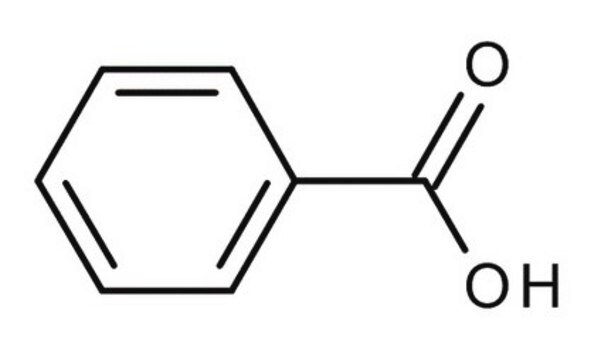33047
Benzoesäure
puriss. p.a., ACS reagent, reag. Ph. Eur., ≥99.9% (alkalimetric)
Synonym(e):
Benzenecarboxylic acid, Carboxybenzene
About This Item
Empfohlene Produkte
Qualität
ACS reagent
puriss. p.a.
Qualitätsniveau
Agentur
reag. Ph. Eur.
Dampfdichte
4.21 (vs air)
Dampfdruck
10 mmHg ( 132 °C)
Assay
≥99.9% (alkalimetric)
Form
crystalline
Selbstzündungstemp.
1061 °F
Verunreinigungen
readily oxidisable substances, in accordance
≤0.002% S-compounds (as S)
≤0.005% halogen compounds (as Cl)
≤0.005% insoluble in methanol
Glührückstand
≤0.005% (as SO4)
bp
249 °C (lit.)
mp (Schmelzpunkt)
121-125 °C (lit.)
Löslichkeit
water: soluble (2.9 g/l at 25 °C)
Anionenspuren
sulfate (SO42-): ≤20 mg/kg
Kationenspuren
Cu: ≤5 mg/kg
Fe: ≤5 mg/kg
Pb: ≤2 mg/kg
Zn: ≤5 mg/kg
Funktionelle Gruppe
carboxylic acid
phenyl
SMILES String
OC(=O)c1ccccc1
InChI
1S/C7H6O2/c8-7(9)6-4-2-1-3-5-6/h1-5H,(H,8,9)
InChIKey
WPYMKLBDIGXBTP-UHFFFAOYSA-N
Suchen Sie nach ähnlichen Produkten? Aufrufen Leitfaden zum Produktvergleich
Allgemeine Beschreibung
Anwendung
- paints
- pigments
- varnish
- wetting agents
- aroma compounds
- benzoyl chloride
- benzotrichloride
Signalwort
Danger
H-Sätze
Gefahreneinstufungen
Eye Dam. 1 - Skin Irrit. 2 - STOT RE 1 Inhalation
Zielorgane
Lungs
Lagerklassenschlüssel
6.1C - Combustible acute toxic Cat.3 / toxic compounds or compounds which causing chronic effects
WGK
WGK 1
Flammpunkt (°F)
Not applicable
Flammpunkt (°C)
Not applicable
Persönliche Schutzausrüstung
dust mask type N95 (US), Eyeshields, Faceshields, Gloves
Hier finden Sie alle aktuellen Versionen:
Besitzen Sie dieses Produkt bereits?
In der Dokumentenbibliothek finden Sie die Dokumentation zu den Produkten, die Sie kürzlich erworben haben.
Kunden haben sich ebenfalls angesehen
Unser Team von Wissenschaftlern verfügt über Erfahrung in allen Forschungsbereichen einschließlich Life Science, Materialwissenschaften, chemischer Synthese, Chromatographie, Analytik und vielen mehr..
Setzen Sie sich mit dem technischen Dienst in Verbindung.








